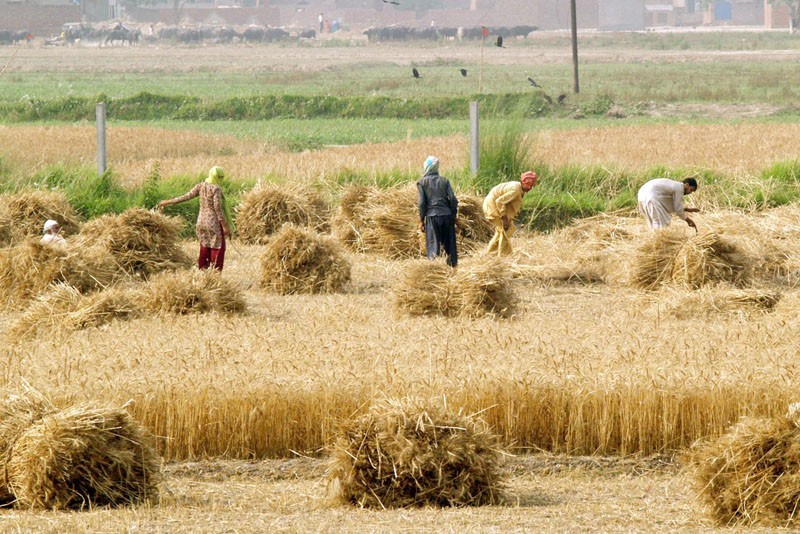
Scarcity of water, poor quality of seeds, power shortages and more are adding to the cost of farming

As the cost of farming has escalated beyond imagination, small farmers are in a fix. Take cotton crop, for example. According to experts, the cost of land preparation before sowing cotton seed is Rs5,000 per acre, the cost of seeds is Rs2,000, the rate of fertilizer like DAP is Rs3,000 per bag and the price of three urea bags used to cover one acre is Rs5,400. An acre of land is watered 15 times and the diesel used to pump out this water costs Rs10,950. Pesticides sprinkled over a period of five month cost Rs25,000. The farmers who pick cotton charge Rs7,500 per acre. Altogether, the cost of growing an acre of cotton in one season comes to Rs58,850.
The average production of cotton is 1200kg (around 30 maunds) per acre. The buyers buy cotton for Rs2,500 per 40kg (one maund), so the price for 1,200kg or 30 maunds becomes Rs75,000.
So not much is left with the tenants after they have paid thaika (contract) to the landlord.
To add to the farmers’ predicament, says Khalid Mahmood Khokhar, president Pakistan Kissan Itehad, who represents farmers mostly with small landholdings, "banks avoid to sanction agriculture loans, to farmers who do not have land titles in their name".
He adds, "Farmers cannot buy virus-free seed and quality fertilizers. They have to depend on aarhati (broker) who gives them loans and buys the crop at a pre-decided price. A major component of this loan is in kind and the broker in exchange gives low quality seed and adulterated fertilizers at a high cost".
Saifullah, a farmer in South Punjab, says that some farmers are so depressed that they are changing their profession. Many have migrated towards urban areas to find livelihood as labourers and several have become dacoits and criminals. A large number of them have gone to the Gulf region to find jobs and many others are still trying.
Due to the fall of prices of wheat and cotton, he adds, farmers are opting for sugarcane, as they find sugar mills are ready buyers. "District Rahim Yar Khan is the best example, where six sugar mills have been set up: Jamal Din Wali Sugar Mills Limited, Jamal Din Wali Sugar -2 (United) Mills Limited, Hamza Sugar Mills Limited, Etihad Sugar Mills Limited, RYK Sugar Mills Limited, and Chaudhary Sugar Mills Limited."
Khalid Khokhar says that the decline in cotton crop has created many problems for women who used to pick cotton, such as not being able to earn and save money for their dowry.
Farmers in Sindh also face similar issues. Hassan Ali Chanio, former minister of agriculture, Sindh, says inputs, including fertilizers, are always of poor quality but nobody is held accountable for such misdeeds. He adds only around 20 per cent of land in Sindh is arable which shows the Sindh government’s lack of interest in agriculture.
"Water logging and salinity is increasing with the passage of time. The government must pay heed to this issue. Using modern technology can reclaim this land. The government should install tubewells in salinity-affected areas. Canals should be lined to control salinity and water logging in Sindh," he demands.
Scarcity of water is also a major issue. Farmers in Sindh claim that their due share of water is not given to haris. So, they have to rely on electric tubewells which are costly. Shortage of electricity has added to their problems too. "Every year, floods spread havoc across the country and crops are destroyed," says Chanio.
He laments that 30 to 40 per cent of water is wasted because the land is not properly levelled. Farmers cannot afford to use laser-levelling technology hence the government must give them incentives to save irrigation water.
Balochistan’s farmers claim the province is facing a huge water crisis as "their share of water is consumed by Sindh and Sindh’s water is used by Punjab", says Mir Changez Khan Jamali, a landowner and tribal leader.
"Balochistan will be a desert after a few years. As water is available beyond 400 feet, digging such deep wells becomes very costly. The government must come forward. Otherwise, people will die of famine in the near future. Growth rate of crops is also falling in Balochistan. Fruit production has fallen drastically," he says.
The situation of farmers in KP is no better, where "83 per cent of population is rural. Naturally, they are connected with agriculture," says Masud Khan, a farmer from KP.
"94 per cent of KP farmers own less than 12 acres of land. The input costs, such as seeds of wheat, maize, mustard, sugarcane, barley and rice are very high and the brokers sell them at inflated prices. That is why many farmers have decided to grow tobacco as this crop gives them better returns. Swabi, Mardan and Charsadda are famous for growing tobacco due to this reason," he adds.